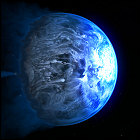 Scientists, analyzing Hubble Space Telescope spectographic data taken during a transit of the exoplanet HD 189733b against its parent star, reveal that they have determined the planet’s color in visible light. The doomed gas giant, only 63 light years away, is said to be a “deep azure blue” not unlike how Earth’s oceans appear from space, though in this case the color is theorized to be the result not of water, but of silicate rain – airborne glass – blowing in 7,000mph winds as the atmosphere is blasted away due to the planet’s proximity to its sun.
Scientists, analyzing Hubble Space Telescope spectographic data taken during a transit of the exoplanet HD 189733b against its parent star, reveal that they have determined the planet’s color in visible light. The doomed gas giant, only 63 light years away, is said to be a “deep azure blue” not unlike how Earth’s oceans appear from space, though in this case the color is theorized to be the result not of water, but of silicate rain – airborne glass – blowing in 7,000mph winds as the atmosphere is blasted away due to the planet’s proximity to its sun.
Skip to content
